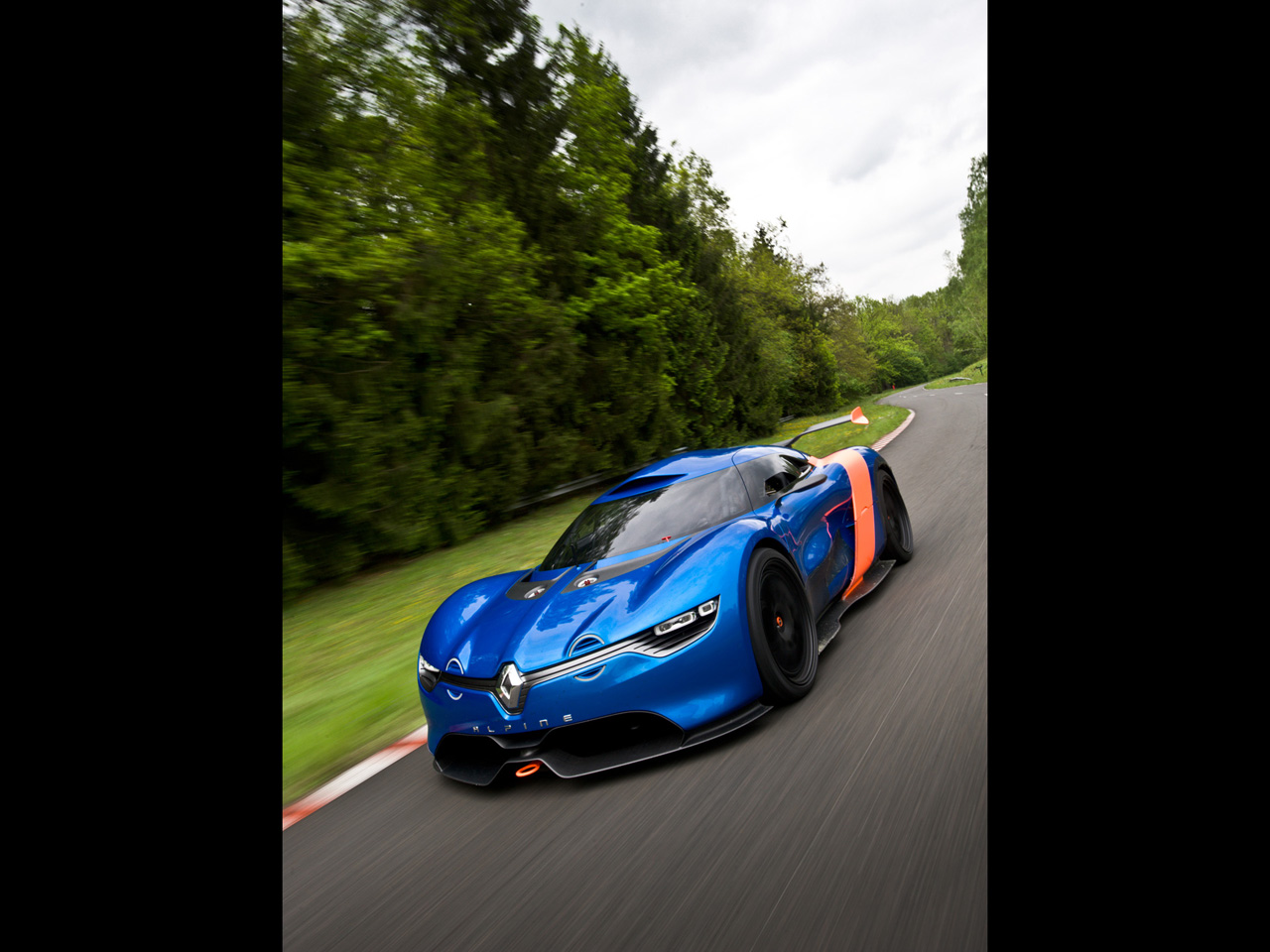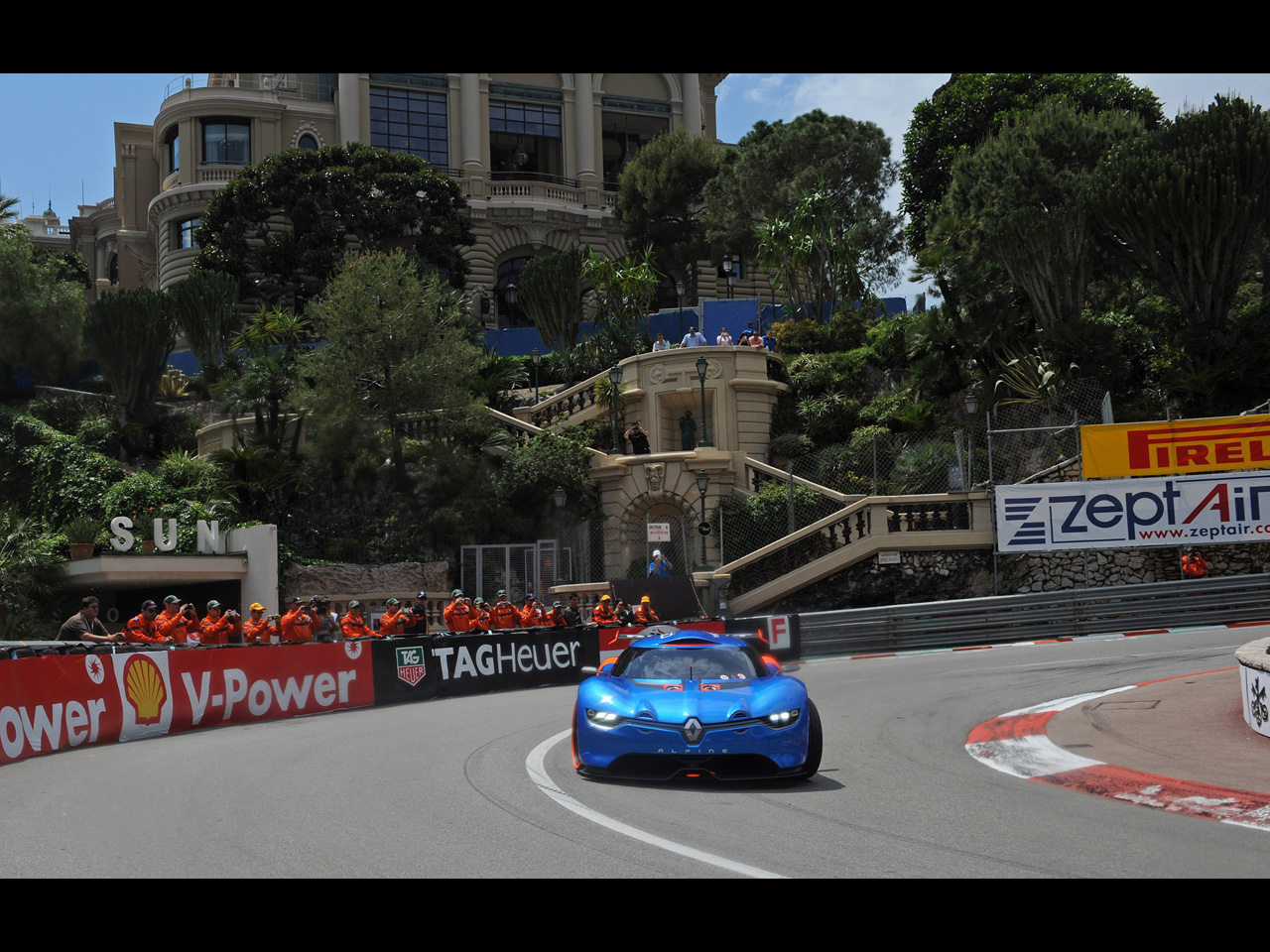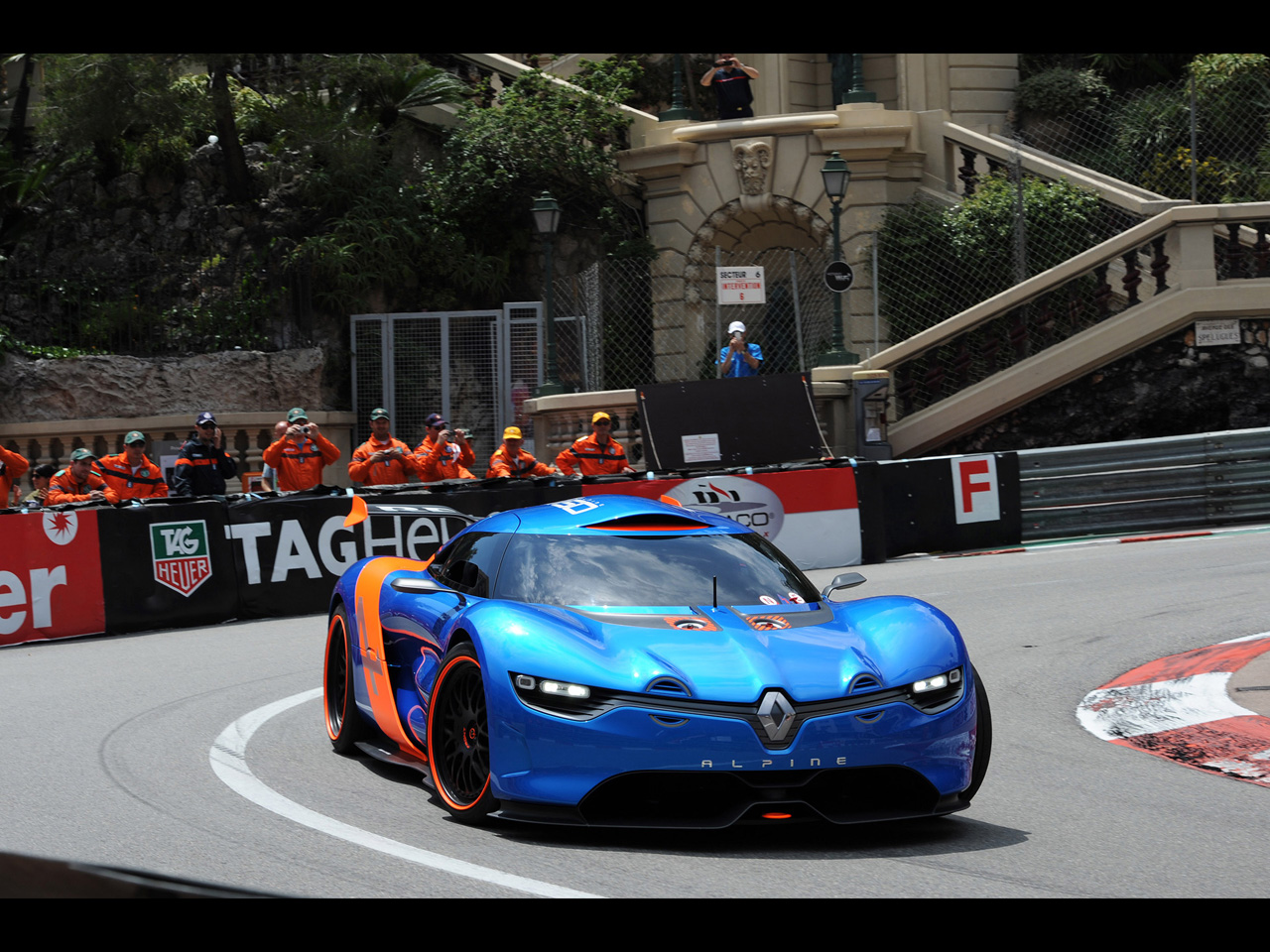2012 Renault Alpine A110-50 Concept
|
Price |
-- |
Production |
-- | ||
|
Engine |
3.5 liter V6 |
Weight |
1940 lbs | ||
|
Aspiration |
-- |
Torque |
311 lb-ft @ 6200 rpm | ||
|
HP |
400 hp @ 7200 rpm |
HP/Weight |
4.9 lbs per hp | ||
|
HP/Liter |
-- |
1/4 mile |
-- | ||
|
0-62 mph |
-- |
Top Speed |
-- |
(from Renault Press Release) A CONCEPT CAR TO CELEBRATE 50 YEARS OF THE ALPINE A110
The Alpine Berlinette turns 50 this year and, to mark the event, Renault has created a concept car named Renault Alpine A110-50, dedicated to performance and driving enjoyment.
So what’s in a nameogon; In some cases, the heritage of a name is like a national treasure – and that’s certainly true for Alpine. Its DNA blends Renault’s sporting passion and technical expertise.
“Developing this concept car was a great adventure. It was a catalyst for creativity. We wanted to make a Berlinette that was of our time, and which boldly embodies Renault’s passion for motorsport. We were guided by our hearts and emotions.” Axel Breun, Concept and Show Car Director.
CHAPTER 1: The creation of the Renault Alpine A110-50 concept car
A new interpretation
of a timeless design
To mark the 50th anniversary
of the iconic Berlinette, Design Yann Jarsalle and Concept and Show
Car Director Axel Breun reinterpreted the original design cues to
include the new Renault design language introduced by Laurens van
den Acker with the DEZIR concept car, and which will soon be rolled
out in the company’s future models. The new front-end look, with the
upright, confident diamond, has been adapted for this very low and
wide car. The Renault Alpine A110-50 is a car of today; a bold
embodiment of RENAULT’s passion for motorsport.
“For everybody on the team, it was a dream come true to work on an Alpine concept car. We wanted to put this car firmly in the modern day, while resonating with its heritage” Laurens van den Acker, Senior VP, Corporate Design.
The Renault Alpine A110-50 concept car translates the most characteristic design features of the original A110 in a modern and spectacular way with:
Produced by Faster, the carbon-fibre bodywork features a new shade of blue which refreshes and reinterprets the famous original ‘Alpine Blue’. Every opening panel does so with dynamics worthy of the finest GTs, with the bonnet hinged at the front and the engine bay cover opening towards the rear. The doors feature a scissor motion.
“The car is very curvy, like the Berlinette, while expressing the three key words of our new design policy: simple, sensual and friendly” Axel Breun.
A competition-focused
cockpit
As you climb into the driving seat, the eye is drawn to the carbon-fibre
sills. Everything inside this two-seater expresses build quality and
sportiness, with black dominant.
harness belts and different, attractive shades of blue.
incorporates a colour screen and houses the same technology as a
Formula Renault 3.5
single-seater to provide drivers with all the information they
need.
CHAPTER 2: the Renault Alpine A110-50 concept car – Chassis and suspension
A true prototype
Produced with the renowned expertise of Renault Sport Technologies,
the Renault Alpine A110-50 is imbued with the world of motorsport.
It benefits from the experience gained from the racing Mégane Trophy
by using the same technical platform. Acclaimed by drivers in the
WORLD SERIES by RENAULT, the tubular chassis of the Renault Alpine
A110-50 has beenstiffened and undergone several developments. The
roll cage and bracing in the engine bayhave been modified (lowered)
in the workshop of Tork Engineering to adapt them to thevehicle’s
height, which is lower than that of Mégane Trophy. The digital
design work was led byRenault Design, Koller and Etud Integral,
while final assembly was carried out by Protostyle. The final weight
distribution is almost ideal, with 47.8% over the front wheels.
To facilitate servicing, the concept car features integral pneumatic jacks. Derived directly from the systems seen in endurance racing, they allow the wheels to be changed extremely quickly. An exceptional car that fuses elegance and aerodynamic efficiency
The efficiency of the Renault Alpine A110-50 concept car is largely generated by ground effect. At the front, a splitter hidden in the bumper generates low pressure, which results in significant aerodynamic downforce. At the rear, a diffuser accelerates air flow beneath the floor. Ground effect therefore accounts for more than one-third of the car’s downforce, with the rest coming from an adjustable rear wing.
The research and design
of this air flow was conducted using Computational Fluid Dynamics, a
cutting-edge technology used particularly in F1. CFD involves
studying movements of a fluid, or
their effects, by resolving digitally the equations which govern the
fluid. This technique was
used by Renault Sport Technologies primarily in order to fine-tune
the aerodynamics and study
the behaviour of the New Mégane Trophy as a function of air flow.
Exemplary road
holding
The wheelbase of the Renault Alpine A110-50 is identical to that of
Mégane Trophy (2,625mm),
while the track is slightly wider at 1,680mm front and 1,690mm rear.
The 21-inch wheels, with a single central nut, are specific to this
car and fitted with roadhomologated Michelin tyres. The Sachs
dampers can be adjusted in compression and extension, and are
mounted directly onto the lower wishbones. There are numerous
different set-up options: castor, camber and alignment, ride height,
anti-roll. In order to improve driver feedback, driving aids
like ABS, traction control, etc. are not fitted.
Serious stopping power
The braking capability of the Renault Alpine A110-50 match its
performance. At the front, large
356mm-diameter steel discs are slowed by six-piston callipers. At
the rear, the discs are 330mm
in diameter, while the callipers are four-piston models.
CHAPTER 3: the Renault Alpine A110-50 concept car – Engine and gearbox
Mechanical excellence
Developed on the same technical platform as Mégane Trophy, the
Renault Alpine A110-50
concept car also boasts the same chief technical characteristics.
It runs the Renault V4Y
engine block, a 3.5 litre 24-valve 400hp V6 mounted in a mid-rear
position. The crankcase (semi-wet), moving parts (pistons,
connecting rods, crankshaft), valve train (camshafts and valve
springs) and exhaust system are specific compared to the version
featured on productions models. Furthermore, the Renault
Alpine A110-50 uses the carbon air intake employed for Mégane
Trophy V6.
The inlet manifold is fed by a new roof-mounted air intake. This
development broadens the
engine’s power band, with additional horsepower at all engine
speeds. The engine mapping has
been optimised for these modifications.
F1-style transmission
The Renault Alpine A110-50 concept car is fitted with a
semi-automatic six-speed sequential
gearbox, as well as a twin-plate clutch that can be controlled using
either the clutch pedal or a
paddle on the steering wheel.
The gearbox is fitted
longitudinally behind the engine and incorporates a limited-slip
differential
(discs and ramps) with adjustable pre-loading.
The cerametallic
twin-plate clutch is also specific to the car. It is activated
automatically when
downshifting, guaranteeing fast and reliable gear changes.
A black box at the
heart of Renault Alpine A110-50
Supplied by Magneti-Marelli, the Marvell 6R electronic control unit
includes functions for engine
management, gearbox control and data acquisition.
Even more accurate
data acquisition
All data collected by the Renault Alpine A110-50 can be analysed
using version 4 of the benchmark Wintax software. Wintax 4 enables
advanced analysis of more than 50 parameters:
engine speed, gear, steering angle, car speed, throttle position,
brake pressure… This
information allows drivers and engineers to optimise settings and
driving style. Wintax 4 data
analysis also enables even faster diagnosis of any technical
problems.
“Developing this concept
car was a great adventure. It was a catalyst for creativity. We
wanted to make a Berlinette that was of our time, and which boldly
embodies Renault’s
passion for motorsport. We were guided by our hearts and emotions.”
Axel Breun.
Technical data
CHASSIS Type Tubular 25CD4S steel chassis with semi-load bearing
engine
and gearbox
BODYWORK Carbon Aerodynamic features Front splitter, diffuser, rear
wing
ENGINE Position Longitudinal, mid-rear
Type Renault V4Y – 6 cylinders – 24 valves – 3,498cc
Bore x stroke 95.5mm x 81.4mm
Injection/ignition Magneti-Marelli Marvell 6R
Maximum power 400hp at 7,200rpm
Maximum torque 422Nm at 6,200rpm
Maximum revs 7,500rpm
TRANSMISSION
Type Rear-wheel drive
Gearbox Six speeds + reverse – sequential
Gear shift Semi-automatic (pedal-operated clutch and paddle)
Differential Limited slip differential
Clutch Cerametallic twin-plate 184mm-diameter clutch
SUSPENSION & BRAKES
Suspension Double wishbones, adjustable two-way Sachs damper/spring
assemblies, front anti-roll bar
Front brakes Ventilated steel discs (Ø 356mm x 32mm) with six-piston
AP
Racing callipers
Rear brakes Steel discs (Ø 330mm x 32mm) with four-piston AP Racing
callipers
WHEELS & TYRES
Wheels Aluminium alloy - Front: 8 x 21 / Rear: 9.5 x 21
Tyres Michelin 245-35 x 21 (front) and 265-35 x 21 (rear)
DIMENSIONS, CAPACITIES
Length/width/height 4,330mm / 1,961mm / 1,230mm
Front/rear track 1,680mm / 1,690mm
Fuel tank 30 litres
Kerb weight 880kg
CHAPTER 4: Renault Alpine A110-50 – The legacy of the Berlinette
1962 - A star is born
When Jean Rédélé unveiled the A110 Berlinette at the 1962 Paris
Motor Show, it marked the start of an Alpine adventure for the
engine from the Renault 8. The car had been developed from the
Alpine A108, but was more stylish and more dynamic, with an even
lower engine cover, a larger glazed area and the rear lights from
the Renault 8. The new engine demanded changes to the air intakes:
with the radiator mounted at the rear, cooling exits were opened in
the resin bodywork behind the rear wheel arches, disguised with four
chrome strips. The changes served only to heighten the elegance of
the A110 Berlinette. The restrained, balanced silhouette
maintained its extremely pure lines.
A car for the
enthusiast
To drive a Berlinette is a life-changing experience. Above all, it
was designed to win rallies, so
it's not surprising that it boasts a certain pedigree; not a tricky
personality, but real character.
You don't climb aboard an Alpine, you slide into it. But once you're
behind the wheel, the
connection is immediate. Agility and traction are particular strong
points thanks to the mid-rear
position engine, which tends to produce oversteer that is easy to
control using the steering and
throttle. It's sometimes a little trickier to keep going in a
straight line, but life's all about
compromise... This isn't a car you simply take for a drive – it
demands to be properly driven. Its
weaknesses are also its strengths.
CHAPTER 5: The Berlinette – A look back at a glorious past in motorsport
The Berlinette in
motorsport
The light weight and handling qualities of the Berlinette meant it
was perfectly suited for
motorsport. As well as being fun to drive, the cars were favourites
with the fans, who often saw
them cornering hard at lurid angles. It's almost impossible to
catalogue every motorsport
triumph for the Berlinette, but these are the main stages of the
adventure.
1961-1968: the early
successes
José Rosinski took the first win for the A110 at the 1963 Rallye des
Lions. The remainder of the
season followed this trend, with exploits including a win for
Jacques Cheinisse on the Rallye
d'Automne.
In the years that
followed, a number of 'privateer' drivers achieved success at
national and
international level ahead of much more powerful cars from
well-established brands.
- 1967: assembling a
great team
Alpine became Alpine-Renault. New drivers joined the line-up: Gérard
Larrousse, Jean-Claude
Andruet and Jean-Pierre Nicolas in the works team, but also, among
others, Bernard Darniche
in the privateer ranks.
- 1968: the first
French Rally Championship title
After victories on the Neige et Glace and Rallye de Lorraine for
Gérard Larousse, Jean-Claude
Andruet claimed the French title thanks to a total score of four
wins during the season.
1969: Hitting its
stride
Jean Vinatier and Jean-Claude Andruet were the stars of the season,
with the former going on
to become the French Rally Champion at the end of the year.
1970: European and
French titles
The Berlinette 1600S was homologated for Group 4, which finally
allowed the car to fight on
almost equal terms with more powerful competitors. Jean-Claude
Andruet, who had calmed his
approach after several notable incidents, was crowned French and
European Champion.
1971: The Berlinette
dominates the Rallye Monte-Carlo
Another good year. Ove Andersson won the Rallye Monte-Carlo. Thérier
finished second and Andruet third. Andersson also took the win in
Italy against the flotilla of Fiats and Lancias dispatched to beat
him. He subsequently triumphed on the Austrian Alpine Rally and on
the Acropolis, securing the international title for Alpine.
Jean-Pierre Nicolas won the French Championship.
1972: Heading for
glory
The 1,600cc engine was replaced by a more powerful 1,800cc unit.
Jean-Claude Andruet dominated the Tour de Corse. Numerous wins
followed, shared between the team's drivers. Darniche was crowned
French Champion at the end of the year, while Jean-Luc Thérier
claimed the Rallye des Cévennes driving a turbocharged 1,600cc
version. This was the first stirrings of a technology destined for
major success...
1973: The climax of
an era
Just imagine the best French drivers of the era: Andruet, Darniche,
Thérier, Nicolas and Piot ably supported by the experienced
Andersson. What's more, a team of mechanics giving their heart and
soul, plus a car at the peak of its development. The season began
with victory for Andruet on the Rallye Monte-Carlo, followed home by
four other Alpines. In Portugal, Thérier and Nicolas scored a
one-two. On the Rallye du Maroc, Darniche was unbeatable. And the
rest of the season followed the same trend. Alpine won the inaugural
World Rally Championship title and Jean-Luc Thérier was crowned
French Champion.
1974 – 1975: the end
of the works era
Nicolas won the Rallye du Maroc and finished second on the Tour de
Corse. This was the Berlinette's swansong, and the year produced the
last major win for the A110 on the Critérium des Cévennes, driven by
Jacques Henry.



